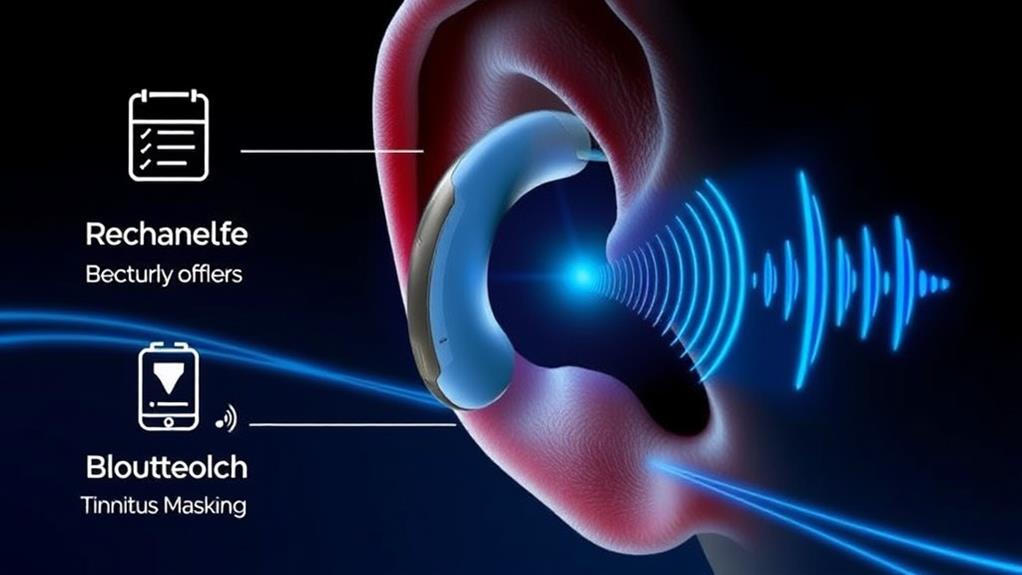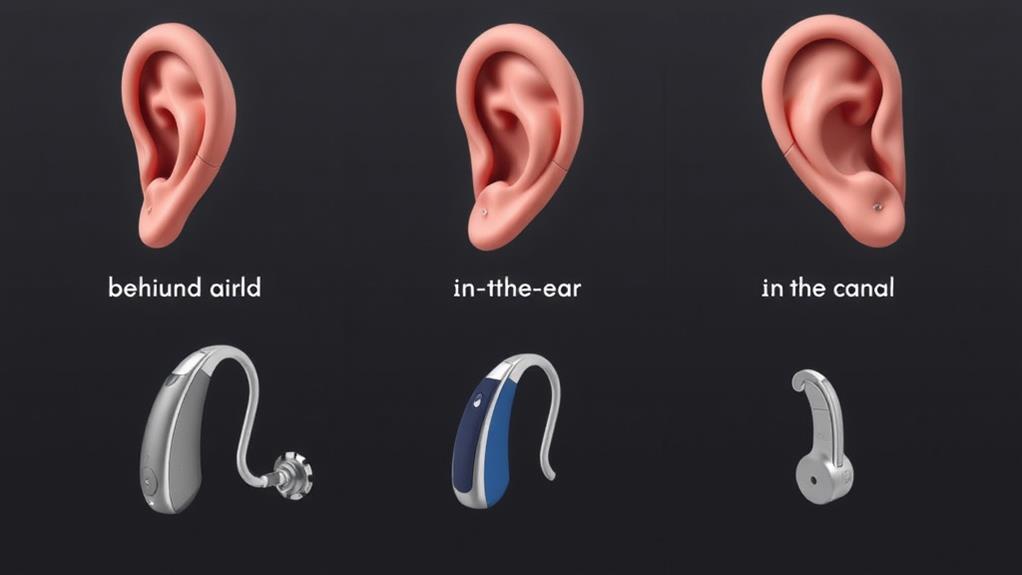When you're dealing with severe hearing loss, finding the right hearing aid can greatly improve your quality of life. Behind-the-ear (BTE) and in-the-ear (ITE) models are highly recommended for their powerful amplification and customization options. BTE aids are particularly effective due to their ability to handle severe to profound hearing loss, offering features like directional microphones and telecoils for enhanced sound quality. On the other hand, ITE aids provide a more discreet option with substantial sound quality, suitable for moderate to severe hearing loss.
Key Takeaways
- Behind-the-Ear (BTE) hearing aids are highly recommended for severe hearing loss due to their powerful amplification capabilities.
- In-the-Ear (ITE) hearing aids are also suitable for severe hearing loss, offering quality amplification and discreet designs.
- Receiver-in-Canal (RIC) hearing aids provide a balance between aesthetics and functionality, suitable for various degrees of hearing loss.
- Digital hearing aids offer advanced noise reduction and programmable features, enhancing communication and reducing stress.
- Consulting an audiologist is essential to select the best hearing aid based on individual needs, lifestyle, and preferences.
Severe Hearing Loss Solutions
Severe hearing loss can be a real game-changer, but don't worry, there are solutions that can help you stay connected and live life to the fullest. Let's talk about assistive listening devices and communication strategies that can make a big difference. For severe hearing loss, you'll want hearing aids that pack a punch – think behind-the-ear (BTE) or in-the-ear (ITE) models. These powerhouses offer more amplification and are designed to help you hear in noisy situations. BTE hearing aids are super popular because they're like the Swiss Army knife of hearing aids – they've got lots of features and can be customized to fit your needs. ITE hearing aids are like the stealthy ninjas of the hearing aid world – they're small, discreet, and can still deliver big sound.
It's also essential to evaluate the comfort level and ease of use of these devices. Many of the top models feature user-friendly interfaces and lightweight designs that reduce ear fatigue. And don't forget about communication strategies like lip reading, sign language, and using visual aids to help you stay on top of conversations. It's all about finding the right combo that works for you and your lifestyle. So, don't be afraid to explore and find what makes you hear happy.
Choosing the Right Hearing Aid
When it comes to severe hearing loss, selecting the right hearing aid can greatly impact the quality of life. You need to evaluate what will work best for you, and that's where consulting an audiologist comes in. They'll assess your specific needs and recommend the most suitable options based on your degree of hearing loss, lifestyle, and personal preferences. Think of it like finding the perfect pair of glasses – you want them to be comfortable and help you see the world clearly. Same with hearing aids. You need them to not only amplify sound but also to be comfortable and easy to use. So, discussing your options with an audiologist is essential. They can help you navigate through the different types of hearing aids, from the discreet Receiver-In-Canal (RIC) models to the more powerful Behind-The-Ear (BTE) models. Your audiologist will also take into account factors like customization options and compatibility with assistive listening devices to guarantee you get the best possible hearing experience. It's like getting a customized sound system for your ears. Advanced noise reduction technology and user-friendly interfaces are also important features to contemplate for an enhanced auditory experience.
Advanced Hearing Aid Features

Advanced hearing aid features play an essential role in enhancing the auditory experience for individuals with severe hearing loss. When you're dealing with considerable hearing loss, you need more than just a basic amplifier. You need smart connectivity that seamlessly integrates with your phone, TV, and other devices. This isn't just about convenience; it's about clarity. Advanced Bluetooth connectivity allows for direct audio streaming and hands-free phone calls, greatly improving sound quality and reducing interference.
Noise cancellation is another game-changer. You might wonder how it works. Imagine you're in a bustling café, trying to catch up with friends. Traditional hearing aids would amplify everything, including the clinking cups and background chatter. Advanced noise cancellation technology, however, can isolate voices and reduce background noise, making it easier to focus on what matters.
These features aren't just about hearing better; they're about living better. With the right hearing aids, you can enjoy movies without subtitles, engage in conversations without straining, and even pick up on those subtle sounds you've been missing. It's not just about hearing; it's about reconnecting with the world around you.
Benefits of Digital Hearing Aids
Digital hearing aids offer several benefits for individuals with severe hearing loss. One of the most notable advantages is their digital signal processing technology. This feature allows the hearing aid to amplify specific frequencies and sounds that you have difficulty hearing, rather than just making everything louder. This means you can hear more clearly in both quiet and noisy situations.
Another key benefit is the advanced noise reduction technology. This feature helps reduce background noise, allowing you to focus on the sounds you want to hear. For example, in a crowded restaurant, you can tune in to your friend's voice and tune out the chatter around you. This makes communication much easier and less stressful.
Additionally, digital hearing aids can be programmed to suit your unique hearing needs. They can also be adjusted to different listening environments, ensuring that you always hear the best possible sound. With these benefits, digital hearing aids can greatly improve your quality of life, making everyday conversations and activities more enjoyable and manageable.
Hearing Aid Style Considerations

Choosing the right hearing aid style is essential for maximizing the benefits of digital hearing aids. You need a style that fits your lifestyle and hearing needs. Let's break it down:
When it comes to severe hearing loss, you have a few key options:
- Behind the Ear (BTE): These are powerful, easy to clean, and have large controls. They're a bit bigger, but they come in different colors and mini sizes to make them less noticeable.
- In the Ear (ITE): These are compact, not as small as some canal aids, and can include a telecoil switch for phone use and a situation switch to reduce background noise. They're suitable for various hearing losses from mild to severe.
- In the Canal (ITC): These fit inside the ear canal and are popular for their small size and dual microphone system. They're best for mild to moderate hearing losses.
- Completely in the Canal: These are super small, great for cosmetics, and make phone use easy. However, they can be pricey and might cause the occlusion effect where your voice sounds too loud. They're best for mild to moderate hearing losses.
Conclusion
Sure, here is the conclusion you requested:
Top hearing aids for severe hearing loss offer powerful solutions to enhance your quality of life. BTE and ITE models are highly recommended, providing strong amplification and customization options. Advanced features like Bluetooth, noise cancellation, and digital signal processing guarantee clear communication. Don't let severe hearing loss hold you back; choose the right aid and start hearing the world in a whole new way.








